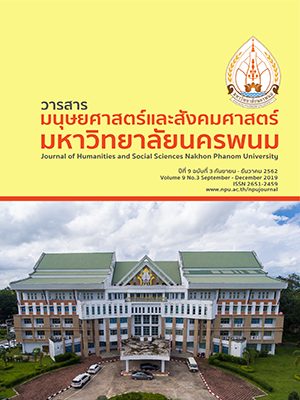Paradigm of collaborative planning for local urban development planning : a case study of Khon Kaen municipality
Main Article Content
Abstract
This article aims to point the meaning and significance of the Collaborative planning and study the paradigm of Collaborative planning that emerged during two eras which remarkable in the process. To suggest the direction of the paradigm in collaborative planning for sustainability. While the author attempted to discuss the fact that the Khon Kaen Municipality's the Collaborative planning paradigm for urban planning took place at two different times. It is not the Collaborative planning in principle entirely. So, it is not sustainable for what reason. The findings showed the Collaborative planning by coorporation to develop the city of all sectors. Especially to emphasis the power of people involved at every stage of the process; Pre-Negotiation, Negotiation and Post- Negotiation. For Khon Kaen Municipality, at some stage found the role of the public sector is lacked and avoided consensus which the key principle of the process. This showed the government agencies who play a role in regulating urban development lacked in understanding the paradigm of Collaborative planning and stick with the original structure. Therefore, the paradigm of Collaborative planning seen through government agencies remains attached to the old bureaucracy. The public opinion is just only to comply with the rules laid down. The power of decision about budget which to be monitored and evaluated should be joint action between the government sector and the people. The operation was carried out by the government sector only, the public sector did not participate all of process follow the principle of Collaborative planning. Consequently, it is not sustainable in the system of urban development planning to drive and change from every sector involved is driving forces, comment and decide including also monitor and evaluate every step.
Article Details
References
ทุนทางสังคมสู่การสร้าง “พลังพลเมือง”. สมัชชาพลเมือง กระบวนการพัฒนาประชาธิปไตย และการมีส่วนร่วม
ของประชาชน. กรุงเทพมหานคร. สำนักการพิมพ์ สำนักงานเลขาธิการสภาผู้แทนราษฎร.
ถวิลวดี บุรีกุล.(2552).พลวัตการมีส่วนร่วมของประชาชน : จากอดีต จนถึงรัฐธรรมนูญแห่งราชอาณาจักรไทย พุทธศักราช
2550. กรุงเทพฯ : เอ.พี. กราฟิก ดีไซน์และการพิมพ์
เทศบาลนครขอนแก่น.(2554). สภาเมือง เวทีข้อมูลความคิดเห็นและการตัดสินใจ. ขอนแก่น. เทศบาลนครขอนแก่น.
เทศบาลนครขอนแก่น. (2561). เทศบาลนครขอนแก่น กิจกรรมเทศบาล. [ออนไลน์]. สืบค้นเมื่อ 20 พฤศจิกายน 2561, จาก
https://www.facebook.com/kkmuni.Activity/posts/1871407036414820
ธีระศักดิ์ ธีฆายุพันธุ์. (2550). “สภาเมือง” การบริหารจัดการบ้านเมืองอย่างมีส่วนร่วมของเทศบาลนครขอนแก่น.รายงาน
การศึกษาอิสระปริญญารัฐศาสนศาสตร์มหาบัณฑิต วิทยาลัยการปกครองท้องถิ่น มหาวิทยาลัยขอนแก่น.
พิชญ์ พงษ์สวัสดิ์. (2559). ประเทศไทยในยุค “รัฐนิยมใหม่” . [ออนไลน์]. สืบค้นเมื่อ 20 ตุลาคม 2561, จาก
https://www.matichon.co.th/columnists/news_138762
สำนักงานราชบัณฑิตยสภา.(2560). Collaborative Planning : การวางแผนแบบรวมพลัง. [ออนไลน์]. สืบค้นเมื่อวันที่ 28
กุมภาพันธ์ 2560, จาก ripub@royin.mail.go.th
Davidoff, P. (1965). Advocacy and Pluralism in Planning. Journal of the American Institute of Planners,
November 31:4: pp.331-338.
Foucault, Michale. (1982). Disclipline and Punish: The Birth or Prison. Harmundsworth : Penguin Books Ltd..
Gunton, T. I., Day, J.C. & Williams, P.W. (2003). Evaluating collaborative planning: The British Columbia
experience. Environments.
Harper, T. L. & Stein, S. M. (2006). Dialogical planning in a fragmentedsociety. New Brunswick, NJ: Center
for Urban Policy Research.
John F. Forester. (1989). Planning in the Face of Power. The Berkeley Planning Journal: the University of California.
McGee, G. J. A. (2006). Evaluating collaborative planning: A case study of the north coast land and
resource management plan. MRM Report 399. Burnaby, BC:
Neil Harris. (2002). ‘Collaborative planning: from theoretical foundations to practice forms’. Planning
Futures: New Directions for Planning Theory. London: Routledge
Nigel Taylor (1998). Urban Planning Theory since 1945. London: Sage.
Osé Luis Yagüe and Christian Barrantes. (2012). PLANNING THEORY IN POSTMODERNITY. Adolfo Cazorla & James Midgley, PLANNING AND COMMUNITY DEVELOPMENT:CASE STUDIESUC Berkeley – Technical University of Madrid. Madrid (Spain): Grupo GESPLAN-UPM.
Patsy Healey. (1997). Collaborative Planning: Shaping Places in Fragmented Societies. University of
Columbia: Canada.
Richard D. Margerum. (2002). Collaborative Planning Building Consensus and Building a Distinct Model for
Practice. Journal of Planning Education and Research. Association of Collegiate of planning.
Sandercock, L. (1998). The death of modernist planning: Radical praxis for a post modern age, in Douglass,
M. and J. Friedman (eds.) Cities for Citizens, New York, NY: J. Wiley, 163-184.
Susskind, L., Wansem, M.W., & Ciccarelli, A. (2003). Mediating land use disputes: Proandcon.
Environments. 31(2), 39-58.
The Co-Intelligence Institute.(2008). Principles of Public Participation. Derived June 28 2017, from
http://www.co-intelligence.org/CIPol_publicparticipation.html.
Wondolleck, J.M., & Yaffee, S. L. (2000). Making collaboration work: Lessons from innovation in natural
resource management. Washington, D.C.: Island Press.


